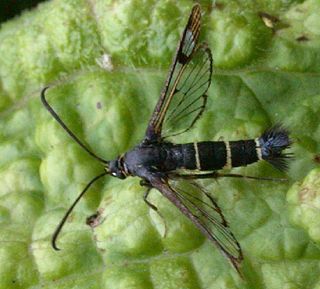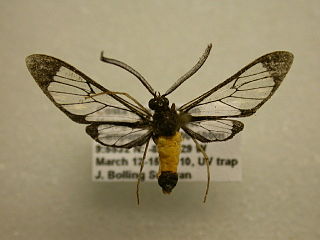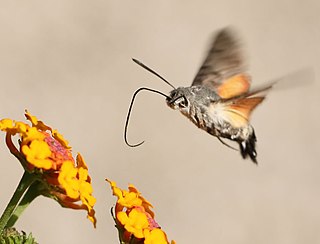
The Sesiidae or clearwing moths are a diurnal moth family in the order Lepidoptera known for their Batesian mimicry in both appearance and behaviour of various Hymenoptera.

The Hepialidae are a family of insects in the lepidopteran order. Moths of this family are often referred to as swift moths or ghost moths.

Acronicta is a genus of noctuid moths containing about 150 species distributed mainly in the temperate Holarctic, with some in adjacent subtropical regions. The genus was erected by Carl Linnaeus in his 1758 10th edition of Systema Naturae. Caterpillars of most Acronicta species are unmistakable, with brightly colored hairy spikes, and often feed quite visibly on common foliate trees. The hairy spikes may contain poison, which cause itchy, painful, swollen rash in humans on contact. The larva of the smeared dagger moth is unusually hairy even for this genus. Acronicta species are generally known as dagger moths, as most have one or more black dagger-shaped markings on their forewing uppersides. But some species have a conspicuous dark ring marking instead.

Mesothen is a genus of moths in the subfamily Arctiinae. The genus was erected by George Hampson in 1898.

Lacanobia is a genus of moths in the family Noctuidae.

Crorema is a genus of moths in the subfamily Lymantriinae. The genus was erected by Francis Walker in 1855.

Macroglossini is a tribe of moths of the family Sphingidae described by Thaddeus William Harris in 1839.
Prorella desperata is a moth in the family Geometridae first described by George Duryea Hulst in 1896. It is found in the US states of Arizona and Texas.
Mesothen aurantegula is a moth of the subfamily Arctiinae. It was described by E. Dukinfield Jones in 1914. It is found in Brazil.
Mesothen catherina is a moth of the subfamily Arctiinae. It was described by William Schaus in 1892. It is found in Santa Catarina, Brazil.
Mesothen flavicostata is a moth of the subfamily Arctiinae. It was described by Herbert Druce in 1906. It is found in Peru.
Mesothen ignea is a moth of the subfamily Arctiinae. It was described by Herbert Druce in 1898. It is found in Mexico.
Mesothen inconspicuata is a moth of the subfamily Arctiinae. It was described by William James Kaye in 1911. It is found in Guyana.
Mesothen ockendeni is a moth of the subfamily Arctiinae. It was described by Herbert Druce in 1905. It is found in Peru.
Mesothen petosiris is a moth of the subfamily Arctiinae. It was described by Herbert Druce in 1883. It is found in Ecuador and Bolivia.
Mesothen pyrrha is a moth of the subfamily Arctiinae. It was described by William Schaus in 1889. It is found in Mexico, Honduras, Colombia and French Guiana.
Mesothen rogenhoferi is a moth of the subfamily Arctiinae. It was described by William Schaus in 1892. It is found in Rio de Janeiro, Brazil.
Mesothen semiflava is a moth of the subfamily Arctiinae. It was described by Rothschild in 1911. It is found in Venezuela.

The Euchromiina are a subtribe of tiger moths in the family Erebidae. It was described by Arthur Gardiner Butler in 1876. Many species in the subtribe are mimics of wasps. Euchromiina have always been considered closely related to the subtribe Ctenuchina due to their similarity to moths and wasps. These two subtribes make up around 3,000 valid species, the majority of which occur in the Neotropics.







